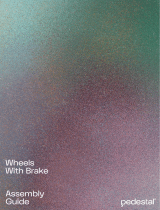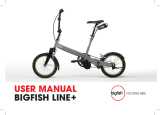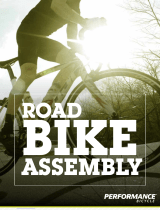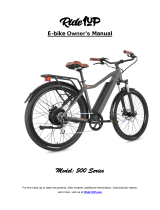Riese Muller Birdy Owner's manual
- Category
- Bicycles
- Type
- Owner's manual
This manual is also suitable for

INSTRUCTION MANUAL
Birdy
Frog

Shifting, p. 36
Derailleur, p. 38
Hub gear, p. 41
Wheel attachment, p. 46
Wheels and tires, p. 44
Brake lever, p. 19
Shifter, p. 37
Seatpost, p. 16
Stem, Handlebar, p. 18
Stem folding hinge, p. 24
Headset, p. 52
Lighting, p. 55
Suspension fork, p. 25
Front swingarm
catch, p. 54
Brakes
Rim brakes, p. 32
Disc brakes, p. 35
Chain, p. 43
Rear suspension, p. 21
Saddle, p. 18

© 2013, riese und müller GmbH
Text and concept
riese und müller GmbH
Graphic Design
www.wolf-corporate.de
Photography
Kay Tkatzik, riese und müller GmbH
Torque settings in this manual
are specied in Nm. Do not rely
on your feeling: “tight” is sim-
ply not precise enough. ONLY a
torque wrench can ensure that
the bolt is properly tightened.
You should always use this tool
to tighten the components to the
specied torque setting. A bolt
that is too tight or too loose can
cause malfunctions which could
lead to an accident.
DANGER!

Dear customer,
Congratulations on your new Riese & Müller bike. Thank you for choosing
us for your mobility needs. Riese & Müller builds lightweight and practical
bikes that are characterized by exceptional handling and award win-
ning design. Your dealer has performed the final assembly of the bike
and possibly implemented some requested changes for you. They have
performed a test ride to ensure an enjoyable riding experience from the
very start. During the design process, we constantly think about your
riding enjoyment and safety. Even though we cannot
anticipate every
possible scenario, this manual answers many of the key
questions you
may have and gives you many tips on using your bike.
Furthermore, a lot of interesting facts about bicycle technology, mainte-
nance and upkeep are summarized for you to ensure that you enjoy your
new Riese & Müller bike for many years for come. If after reading this
manual, you still have questions, please feel free to contact your dealer
or us directly. Since our bikes are constantly being updated and improved,
we may provide additional supplementary pages to ensure you have the
most up to date information. Please be mindful that some updated infor-
mation may have already been included with your new bike.
The Riese & Müller Team

3
4 General information
6 Before the first ride
8 Before every ride
9 Legal requirements
10 Unfolding your Birdy
12 Folding your Birdy
14 Transporting your Birdy
16 Adjusting the riding position
20 Pedals
21 Adjusting the suspension
22 Quick release
24 Stem folding hinge
27 Front swingarm catch
28 Rear swingarm catch
30 Brakes
36 Shifting system
43 Chain
44 Wheels and tires
52 Function of the headset
54 Suspension pivot bearings
55 Lighting system
56 General care/Inspections
59 Warranty/Guarantee
62 Torque settings
64 Service and maintenance plan
66 Documents and service record
CONTENTS

4
GENERAL INFORMATION
Riese & Müller bicycles are equipped with innovative technology. So please read this manual
even if you are an experienced cyclist.
To ensure you always have a fun and safe ride, you should perform the quick check before
every ride. For instructions on this quick check please see page 6.
In this manual, a number of maintenance and repair tasks are described in detail. If you
engage in this activity you must always consider that the instructions are exclusively for the
designated Riese & Müller bicycles and are not transferable to other bikes.
Through a variety of design and model changes it is possible that the included instructions are
not up to date. If necessary, review the separately attached instructions.
Note that the successful execution of the included instructions may require special tools or
technical expertise. If you are uncomfortable performing any of the listed tasks, please seek
the assistance of a professional.
If you reach a certain point where you are not sure how to proceed, please contact your local
dealer or us directly. We are happy to help!
The following are a few things that we cyclists hold very dear. Always take care in trac as
not to endanger yourself or others. Respect the rules of the road so you don’t draw the ire of
other road users. If you tour through forests and meadows, please respect nature by cycling
only on marked or paved roadways. Observe the legal requirements for the o-road use of bi-
cycles, which are available from your local authorities. Never ride without a helmet and make
sure you always wear appropriate clothing.
We hope you enjoy your new Birdy!
Do not ride if the test wasn’t passed with 100% certainty.
DANGER!

5
We’ll begin by telling you about the parts of your Birdy. Open the front cover of this
brochure. Here you’ll find a Birdy with all of the relevant parts clearly shown.
Tip! Keep the front cover opened as this makes orientation easier!
We have tried to vividly portray all of the relevant information to ensure your satisfaction with
your new Riese & Müller bike. Therefore we use the following symbols:
Attention! Here is a hint that will help you quickly become familiar with your bike and its
technology.
Danger! This symbol indicates that life-threatening risks are possible if the correspond-
ing instructions are not followed. Please read carefully.
Tip! This symbol indicates useful additional information.
This manual covers the installation and maintenance work that may be best
performed by your local dealer (p. 62 - 63). Do not perform any task that you are
uncomfortable with. Many of these tasks require special knowledge and tools
and should only be performed by an expert. Never ride your bike with incomple-
te or improper maintenance. You could endanger your life or the lives of others.
DANGER!

6
BEFORE THE FIRST RIDE
CARRIERS/TRAILER BIKES
Only two-wheel trailers with attachment at the rear axle are approved for use with the Birdy.
TRAILER HITCH
We recommend the “Weber-trailer hitch”.
INTENDED USE
Use the Birdy only on streets and surfaced roads. We can take no responsibility for the
consequences of inappropriate use, assembly errors, accidents, racing, jumping
or similar activities.
BIRDY GROSS VEHICLE WEIGHT RATING
(Birdy, rider and carrier load) 120 kg (265 lbs)
MAX. CARRIER WEIGHT RATING
Expedition carrier 15 kg (33 lbs)
Lowrider 10 kg (22 lbs)
SL carrier 12 kg (26 lbs)
Max. trailer weight rating (including carrier weight) 50 kg (110 lbs)
HEIGHT
The Birdy accommodates riders up to a height of 195cm.
Other trailer hitches do not guarantee perfect function of trailer and suspension
and could cause accidents or damage!
DANGER!

7
CLOTHING
Wear bike appropriate clothes. Never ride without wearing a helmet!
BRAKES
Are you familiar with the braking system? Check to make sure that the front brake lever is on
the side of the handlebar that you are used to. If it isn’t then you can either train with the new
arrangement or have your dealer change the arrangement to fit your needs.
SHIFTING
Are you confident that you know how to change gears?
Conduct a test ride to familiarize yourself with the shifting system in a low-trac area. You
can read more about gearing systems on pages 36-42.
SEATING POSITION
Are the saddle and handlebar in the right position? Your dealer can assist you in finding the
best seating position. The saddle should be adjusted so that with the pedal in its lowest posi-
tion, you can just reach it with your heel. Check that you can stay in the saddle and still reach
the ground with your tiptoes. Your dealer will be able to help you if you’re not happy with your
saddle position. You can read more about seating position on pages 16-20.
SUSPENSION
Is the suspension adjusted to suit your needs? More information regarding suspension on
page 21.
Modern brakes are much more powerful than simple rim or drum brakes. Make
sure to rst test the braking power before heading into trac. Unintended bra-
king can lead to an accident. Slowly squeeze the brake to generate more braking
force. You can read more about the braking system on pages 30-35.
DANGER!

8
BEFORE EVERY RIDE
Before every journey you must check the following points:
Are the quick releases on the wheels, the stem and the seatpost clamp all correctly fastened?
Read more on pages 22 – 23 of this manual.
• Is the tension lever on the stem hinge closed correctly? Are all hinge parts for the stem hinge
present? More information on page 24 – 26.
• Is the quick release lever on the height adjustable stem closed?
• Is the pin of the height adjustable stem fully snapped into one of the holes.
Read more on page 18.
• Are the rear swingarm catch and the front swingarm catch both correctly engaged? More
about this on pages 27 – 29.
• Are the tires in good condition, are they running true and are they at the correct pressure?
More on this topic on pages 44 – 45.
• Perform a stationary brake test by pulling the levers hard towards the handlebar. The brake
pads should press with their full area against the rims, without touching the tire. You should
not be able to pull the lever right up to the handlebar! Further tips on braking on pages
30 – 35.
• Check that the dynamo is securely mounted. Does the light illuminate properly?
More on lighting on page 55.
• Is the max. load not exceeded (page 6)?
• As you ride, always listen out for unusual rattling noises or unusual handling – these could
indicate a problem. If this occurs, check bearings, pivots, all fasteners and parts of the folding
mechanism.
Do not ride the bike if your bike fails any of these checks! If in doubt, always
consult your dealer. A defective bike can lead to serious accidents!
DANGER!

9
LEGAL REQUIREMENTS
When you ride your bike on the road, it must comply with trac laws and guidelines.
These will vary from country to country. In general, there are minimum standards for brakes,
reflectors and lighting systems, as well as usually a general responsibility to ensure that
your vehicle is in roadworthy and in safe condition. You also have a duty to ride in a safe and
responsible manner. If you ride your Birdy in trac, be sure to observe all relevant laws and
regulations. Please ask your local transportation administration for current information.
BRAKES
In most countries, including Germany and the UK, two independent brakes are
required. Do not ride with only one functioning brake!
LIGHTS
Bicycle lighting systems need to comply with the relevant national standards.

10
UNFOLDING YOUR BIRDY
• Open the seatpost quick-release and raise
the seatpost to the appropriate height (no-
tice the height marks on the post).
• Close the quick-release again. Do not raise
the seatpost beyond the minimum inser-
tion mark (see page 15).
• If your Birdy is equipped with a height-ad-
justable stem, open the height-adjustment
quick-release, press the pin and raise the
stem to the desired height.
• Carefully close the quick-release.
• Check that everything is secure on the
stem, by holding the front wheel between
your legs and attempting to twist the han-
dlebar with your hands. If it doesn’t turn,
it’s secure.
01 02
05
• Unfold the stem and handlebars.
• Close the hinge lever.
ATTENTION!
Do not pull out the seat post above
the minimum insertion mark.
Please read page 23.

11
• Lift the Birdy by the handlebar, unfold the
front wheel and put the Birdy back on the
ground.
• Press briefly on the handlebar, so that the
front spring audibly engages in the front
swingarm catch.
• Adjust the seatpost to the correct height.
Turn the saddle so it is in line with the bike,
by lining up the front of the saddle with the
bottom bracket or along the main frame
tube.
• Check that the seatpost is securely xed
by grasping the front and rear of the sad-
dle and attempting to twist it. If it doesn’t
move at all, it’s secure.
04
06
03
• Lift the Birdy by the saddle, so that the rear
swingarm swings backwards.
• Engage the rear swingarm catch.
If you have one, unfold the kickstand.
ATTENTION!
Under no circumstances should
the stem be raised beyond the
‘MINIMUM INSERTION’ mark.
Check that the pin engages in one
of the holes at the stem.

12
• Fold the front swingarm right under until
the front wheel rests next to the main
frame tube, and the tire grips up against
the fixing screw on the front forks.
• Put the bike back down. If you have one,
fold up the kickstand. Lift the bike a little
by the saddle and open the rear swingarm
catch with a light outward pull.
• Now fold the rear swingarm forward and
put the Birdy back on the ground.
• Now open the seatpost quick release and
lower the saddle as far down as it will go.
Close the quick release.
• Finally, open the stem hinge lever and fold
the handlebars down. Finished!
With a little practice you can easily fold the
Birdy very quickly. The folding procedure is
as follows:
• Select the highest gear – the chain should
be on the smallest sprocket.
• If your Birdy is equipped with a height-ad-
justable stem, open the height-adjustment
quick-release, press the pin and lower the
stem to the lowest pin hole. Close the quick
release again.
• Ensure the right-side pedal points up-
wards (the crank should be in line with
the seatpost).
• Stand on the left side of the Birdy and grip
the handlebar with your right hand. Press
the front swingarm catch with the left
hand, so that it releases the spring from the
fork.
FOLDING YOUR BIRDY

13
BIRDY RACE
The drop bars on this model increase its
folded size. Depending on the setting of the
bar, the end of the bar can touch the brake
disc. This should be avoided as it can cause
brake pad deformation. Additionally the
stem should not be raised to the highest
position because this can place too much
pressure on the brake and shifting cables.
Prior to folding ensure that the chain is
on the largest chainring and the smallest
sprocket to ensure the chain does not jam
or fall o during folding.
TIP!
Do not store the Birdy Rohloff on its side for a long time. There
is the possibility of oil leakage from the Rohloff Speedhub. This is
technically harmless but should be remembered when storing the
Birdy in sensitive areas.

14
Once folded, your Birdy is easily transport-
ed in the trunk of a car, on trains, buses,
ferries and airplanes.
TRAIN TRAVEL
Some train services require that your Birdy
is covered up in a bag, especially if it is
carried on as normal luggage, rather than
placed in the luggage car or designated
storage area. Two Birdy bags are available:
the protective cover and the rucksack bag.
The protective cover slides over the Birdy in
one easy motion, and is closed at the bot-
tom with a pull on the drawcord. The cover
is made from tear-resistant nylon. Like a
poncho, it folds up very small into its inte-
grated mesh pouch, and is then fastened to
the bike. The rucksack bag is an ideal Birdy
accessory. Two large compartments carry
all of your belongings. Open up another
zip and another compartment opens up to
allow you to stow your Birdy. The bike can
then be easily carried with the padded shoul-
der strap or the carry-handle. You can still use
the other luggage compartments. It’s made
from extremely durable Cordura Plus.
AIR TRAVEL
We recommend that when you take your
Birdy on a plane you package it in a strong
box – for example, the box in which it ar-
rived at your dealer. The pedals should be
removed and packaged separately. Another
possibility is the use of the rucksack bag –
we recommend that in this case you use
plenty of additional cardboard and bub-
blewrap to protect against bumps. The rear
derailleur is the most vulnerable part of
the bike: we recommend that you unscrew
it from the frame, wrap it in bubblewrap,
and tape it to the frame so that it won’t be
vulnerable to impacts.
The Birdy suitcase has two small wheels
and can be used like a trolley because of its
telescopic grip. Before putting the Birdy into
the suitcase the pedals must be removed.
Because of the many variations of the Birdy
accessories (fenders, kickstand, carriers,
lighting) is may be necessary to remove
some of them.
TRANSPORTING YOUR BIRDY
Backpack SuitcaseCover
TIP!
If the suitcase gets damaged during the ight please contact the
airlines baggage department immediately to le a damage claim.

15

16
ADJUSTING THE RIDING POSITION
HOW CAN I CHECK MY SEATING POSITION?
A good riding position is important for your
comfort and for optimal performance on the
bike. You need to adjust saddle and handle-
bars very precisely to ensure the best possi-
ble fit. Several components on the Birdy are
designed to adjust to suit your body dimen-
sions. If required, you dealer will be pleased
to change the stem on your Birdy.
ADJUSTING FOR THE CORRECT SADDLE HEIGHT
The need for a comfortable pedaling action
determines the saddle height. It’s important
that when you pedal, the ball of the foot
should be over the center of the pedal axle.
When the pedal is at its lowest position your
leg should not be quite fully extended. If
the saddle is too high, it’s hard to get round
this lowest point, and the pedaling action
becomes uneven. If the saddle is too low,
you’re likely to experience knee pain.
Check the seat height using the following
simple procedure. Use shoes with a flat sole
for this check:
• Sit on the saddle and put your heel on the
pedal, so that it moves to its lowest posi-
tion. In this position the leg should be fully
extended. Note that the hips should stay
straight and level.
• To adjust the seat height, you need to undo
the quick-release.
• The loosened seatpost can now be adjust-
ed for height. Make sure that the seatpost
is not greased. If it doesn’t slide smoothly in
the frame, clean out and remove all grease
from inside the frame and on the seatpost.
If you have further problems, consult your
dealer. It should never require extreme
force to adjust the seatpost.
• Set the saddle straight, by lining up the
saddle nose either with the bottom bracket
or the main frame tube. Close the quick
release.
• Check that the seatpost is securely xed
by grasping the front and rear of the sad-
dle and attempting to twist it. If it doesn’t
move at all, it’s secure.
• Does the leg extension seem correct when
you repeat the test? Check it by moving
your foot to the ideal pedaling position,
with the ball of the foot above the pedal
axle. The knee should now be slightly bent
All of the procedures we are about
to describe require a certain
de-gree of skill, suitable tools and
mechanical aptitude. After any as-
sembly or maintenance procedure,
perform the Quick Check (see page
8) and take a short test-ride some-
where quiet, away from trac.
This lets you check in safety that
everything works properly. If you
have any doubts, it’s best just to do
the riding position check, and then
to explain any changes you’d like
to your dealer. They can carry out
your requests with all the proper
tools and skills, perhaps in con-
junction with the rst inspection.
DANGER!

17
– if this is so, you’ve reached the correct
saddle height.
• Check that you can stay in the saddle and
still reach the ground with your tiptoes. If
this isn’t the case, put the saddle a little
lower.
• Memorize the insertion mark on the
seatpost so that when later unfolding you
immediately know the correct height of the
seatpost.
BIRDY STEMS
Two dierent handlebar stems are available
for the Birdy:
• Sport stem, adjustable – allows sporty posi-
tion for riders of all sizes
• Comfort stem, adjustable – the handlebar
is closer to the saddle and allows a more
upright rider position
Your dealer can change the stem following
your needs.
Upright rider’s position
Advantage: lower load on the wrists, arms
and cervical spine.
Disadvantage: higher load on the saddle.
Sporty rider’s position
Advantage: less loads for the seating area,
more ecient performance, less air resist-
ance, more weight on the front wheel.
Disadvantage: higher loads for the wrists,
arms and cervical spine.
Do not ride if the seatpost is
withdrawn beyond the ‘MINI-
MUM INSERTION’ mark! This
mark must not be visible: if it
is, the seatpost could break or
the frame could be damaged.
The seatpost is not designed for
mounting bags or carriers on
the seatpost or the saddle. This
could overload of the seatpost!
DANGER!

18
ADJUSTING THE HANDLEBARS
• Open the quick release at the stem.
• Press the pin and adjust the stem to the
desired height. The pin has to engage again
into one of the holes.
ADJUSTING THE RIDING POSITION
ADJUSTING REACH AND SETTING
THE SADDLE ANGLE
The distance between the handlebar grips
and the saddle (reach), and the angle of the
saddle, are important factors when it comes
to how much you’re leaning forwards, and
hence for your riding comfort and perfor-
mance. The reach can be adjusted over a
short distance using the saddle rails, by slid-
ing the saddle forward or backward on the
seatpost clamp. This will also aect pedaling:
if the saddle is all the way back, you’ll be
pedaling more “from behind”, and vice versa.
The geometry of the Birdy was designed so
that for normal use, the saddle is positioned
as far forwards as possible. This minimizes
folded size. The saddle should in general be
set dead level.
• Release seatpost clamp bolt A, turning at
most three or four turns anticlockwise.
No more, or the whole assembly can fall
apart.
Do not ride if the stem is ex-
tended beyond the ‘MINIMUM
INSERTION’ mark!
Do not ride if the quick release of
the adjustable stem is not tight-
ened or the pin is not engaged in
one of the holes.
Never open the quick release
while riding!
DANGER!
A
Page is loading ...
Page is loading ...
Page is loading ...
Page is loading ...
Page is loading ...
Page is loading ...
Page is loading ...
Page is loading ...
Page is loading ...
Page is loading ...
Page is loading ...
Page is loading ...
Page is loading ...
Page is loading ...
Page is loading ...
Page is loading ...
Page is loading ...
Page is loading ...
Page is loading ...
Page is loading ...
Page is loading ...
Page is loading ...
Page is loading ...
Page is loading ...
Page is loading ...
Page is loading ...
Page is loading ...
Page is loading ...
Page is loading ...
Page is loading ...
Page is loading ...
Page is loading ...
Page is loading ...
Page is loading ...
Page is loading ...
Page is loading ...
Page is loading ...
Page is loading ...
Page is loading ...
Page is loading ...
Page is loading ...
Page is loading ...
Page is loading ...
Page is loading ...
Page is loading ...
Page is loading ...
Page is loading ...
Page is loading ...
Page is loading ...
Page is loading ...
Page is loading ...
Page is loading ...
Page is loading ...
-
 1
1
-
 2
2
-
 3
3
-
 4
4
-
 5
5
-
 6
6
-
 7
7
-
 8
8
-
 9
9
-
 10
10
-
 11
11
-
 12
12
-
 13
13
-
 14
14
-
 15
15
-
 16
16
-
 17
17
-
 18
18
-
 19
19
-
 20
20
-
 21
21
-
 22
22
-
 23
23
-
 24
24
-
 25
25
-
 26
26
-
 27
27
-
 28
28
-
 29
29
-
 30
30
-
 31
31
-
 32
32
-
 33
33
-
 34
34
-
 35
35
-
 36
36
-
 37
37
-
 38
38
-
 39
39
-
 40
40
-
 41
41
-
 42
42
-
 43
43
-
 44
44
-
 45
45
-
 46
46
-
 47
47
-
 48
48
-
 49
49
-
 50
50
-
 51
51
-
 52
52
-
 53
53
-
 54
54
-
 55
55
-
 56
56
-
 57
57
-
 58
58
-
 59
59
-
 60
60
-
 61
61
-
 62
62
-
 63
63
-
 64
64
-
 65
65
-
 66
66
-
 67
67
-
 68
68
-
 69
69
-
 70
70
-
 71
71
-
 72
72
-
 73
73
Riese Muller Birdy Owner's manual
- Category
- Bicycles
- Type
- Owner's manual
- This manual is also suitable for
Ask a question and I''ll find the answer in the document
Finding information in a document is now easier with AI
Other documents
-
 LECTRIC XP Suspension Seat Post User guide
LECTRIC XP Suspension Seat Post User guide
-
 pedestal 230201 Installation guide
pedestal 230201 Installation guide
-
 Coboc TORINO Owner's manual
Coboc TORINO Owner's manual
-
 Bigfish Line+ User manual
Bigfish Line+ User manual
-
 PERFORMANCE Road bike Assembly
PERFORMANCE Road bike Assembly
-
 Cake Kalk& Electric Motorcycle User manual
Cake Kalk& Electric Motorcycle User manual
-
Kmart 43271443 User manual
-
 Ride1up 500 Series Owner's manual
Ride1up 500 Series Owner's manual
-
Kmart 43271443 User manual
-
Momentum Folding bike Owner's manual















































































